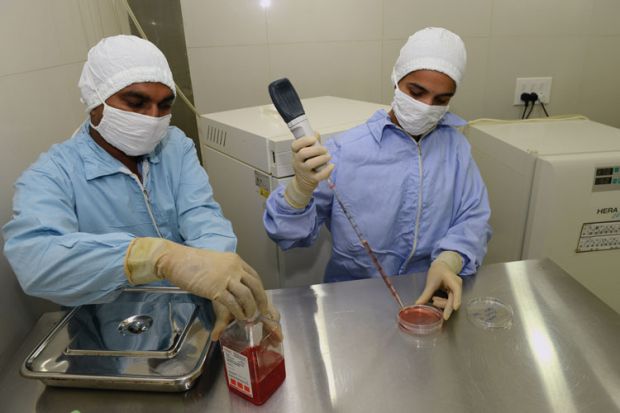Soaring research spending, output and innovation in several of the so-called Brick countries does not always capitalise on those nations’ strongest areas of research, a report suggests.
The report, Building Bricks: Exploring the Global Research and Innovation Impact of Brazil, Russia, India, China and South Korea, published last week by Thomson Reuters, details sharp rises in spending on research and development in the giant emerging economies.
China, for instance, has nearly tripled its research spending as a proportion of gross domestic product since 1996 even as its GDP was growing rapidly. Similarly, South Korea is currently investing a higher proportion of its GDP in R&D than is Germany.
There has been a recent surge in patent filings in both China and South Korea, which the report takes as a measure of innovation. Chinese researchers now file six times as many patents as they did a decade ago.
Meanwhile, the research outputs of all five Brick nations have increased as a proportion of the world total since 2000. Their production of highly cited papers has also increased as a proportion of their total output.
The report finds that the disciplines in which output and patenting are at their highest are generally very similar. However, it notes a marked disparity in several countries between areas of highest output and greatest research strength.
For instance, Brazilian research output is highest in the life sciences, while its top research strengths, measured by citation impact, are in physics, mathematics and engineering. Most Brick nations’ output is concentrated in the physical sciences, while several have particular strengths elsewhere.
Only Russia and South Korea produce their greatest share of the world total of papers in their areas of greatest strength: physics and materials science, respectively.
The report says that the disparity between research volume and strength may be a hangover of the rapidly changing patterns of research investments in Brick countries. But it adds that “strategic work may be required by Brick policymakers to achieve a better translation of investment [into] real achievements that are likely to deliver competitive benefits through new processes and products”.
It also notes that where areas deemed strategically important are showered with funding there can be a decline in quality owing to “low levels of selective peer review”.
Jonathan Adams, one of the authors of the report, said policymakers needed to decide how much they should push the university sector to engage with industrial requirements, or push the commercial sector to engage with cutting-edge research. But he added that there was never likely to be a complete match between the two sectors.
He noted that, in South Korea, the close match between output and research strength was driven by researchers’ own desire for their work to be useful.
Dr Adams also drew attention to large variations among the performances of the various Brick nations, with Russia in particular languishing as a result of underinvestment in research and falling business confidence.
Register to continue
Why register?
- Registration is free and only takes a moment
- Once registered, you can read 3 articles a month
- Sign up for our newsletter
Subscribe
Or subscribe for unlimited access to:
- Unlimited access to news, views, insights & reviews
- Digital editions
- Digital access to THE’s university and college rankings analysis
Already registered or a current subscriber? Login




